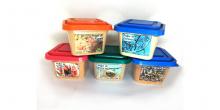Only a century ago, the fruits of this plant (also called Christ's-thorn in English) were part of the trans-Saharan caravan trade.1 And this export from sub-Saharan Africa to Egypt was d “Besides an old tradition: archaeological documents of tax receipts indicate that Nubia paid part of its burdens to the pharaonic power through Ziziphus spina-christi loaves.2 Tragically, this tree is rapidly receding today” today, in geographical distribution as well as in the availability of its fruits on local markets.3 The fact that it is an excellent firewood and utility wood4 has probably played against its conservation.
Its sweet fruits, slightly bitter and with a nutty taste, have a high energy density with 64 to 86% carbohydrates.5 6 They are easily stored in the dried state, and are, among other things, an excellent food for travel . They can also be made into flour, which can then be used to make cookies. The seed is eaten roasted, and contains 30% protein. The flowers are an important source of nectar, and one of the most expensive honeys on our planet, Sidr honey, is produced in Yemen from this nectar.7 According to a Saudi study, each tree is estimated to be able to generate 3.6 kg of honey per year8. And this is in addition to the largest 50 to 200 kg of fruit it produces in Ethiopia.9 The fruits generally ripen during the cold season, in December and January.
The plant adapts to a diversity of soils in the 300mm rainfall band and beyond, and grows throughout the Sahelian band, in North Africa and the Middle East.
Old trees of Z. spina-christi often have hollow trunks, which are important for housing certain insects and animals. This includes snakes, which are not too popular with peasants. At the same time, the thorns of Z. spina-christi are used in North Africa precisely as an antidote for snakebites.
1Algha Kel-Eghazzer of Azanamgre (village north of Agadez). Personal communication to Harouna Souleymane. 2014. Algha estimates his age at 103 years and recollects having loaded the caravans he was part of in his youth going to Bilma with Z. spina-christi fruits. There, parts of the produce would be eaten locally, whilst other parts were transported by the caravans going to Egypt, who would bring back white cloth.
2Lise Manniche. 2006. An Ancient Egyptian Herbal. British Museum Press.
3Josef Garvi, directeur Sahara-Sahel Foods, observ. pers.
4SEPASAL database, Survey of Economic Plants for Arid and Semi-Arid Lands (SEPASAL), Notes FUELS – FUELWOOD. http://www.kew.org/science-conservation/research-data/science-directory/projects/survey-economic-plants-arid-and-semi .Retrieved December 2014.
5Eden Foundation, 1992. Nutritional study on Ziziphus spina-christi. http://www.edenfoundation.org/project/articles_nutritionzizspina.html
6Debela Hunde Feyssa, Jesse T. Njoka, Zemede Asfaw, M.M. Nyangito. 2011. Wild Edible Fruits of Importance for Human Nutrition in Semiarid Parts of East Shewa Zone, Ethiopia: Associated Indigenous Knowledge and Implications to Food Security. Pakistan Journal of Nutrition 10: 40-50, 2011.
7Sweet Health. http://www.sweethealth.co.uk/sidrhoney.html. Retrieved December 2014.
8Adgaba Nuru, Awad M. Awad, Ahmad A. Al-Ghamdi, Abdulaziz S. Alqarni, Sarah E. Radloff. 2012. Nectar of Ziziphus spina-christi (L.) Willd (Rhamnaceae): Dynamics of Secretion and Potential for Honey Production. Journal of Apicultural Science, Vol. 56 No. 2 2012.
9 Debela Hunde Feyssa, Jesse T. Njoka, Zemede Asfaw, M.M. Nyangito. 2011. Wild Edible Fruits of Importance for Human Nutrition in Semiarid Parts of East Shewa Zone, Ethiopia: Associated Indigenous Knowledge and Implications to Food Security. Pakistan Journal of Nutrition 10 (1): 40-50, 2011.
10 Amots Dafni, Shay Levy, Efraim Lev. 2005. The ethnobotany of Christ''s Thorn Jujube (Ziziphus spina-christi) in Israel. Journal of Ethnobiology and Ethnomedicine 2005, 1:8.
